Larger tarpaulins needed for confinement
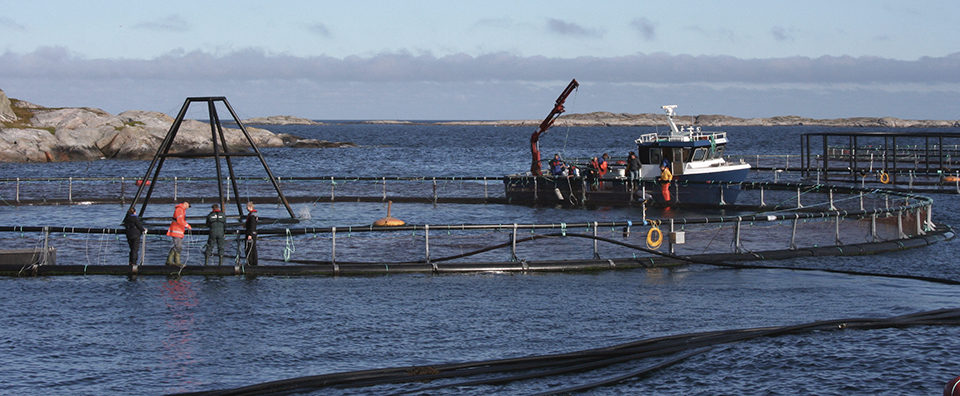
Tarpaulins, skirts provide treatment confinement, distribution
For a long time, sea lice (Lepeophtheirus salmonis) have been infectious and problematic parasites found on both wild and farmed salmonids. In Norwegian salmon farming, the level of infestation can be controlled by good management practices, cleaner fish (wrasse, cork wing, goldsinny) in the net pens and medicinal treatments.
If lice infestations surpass the levels regulated by Norwegian authorities, the fish must be treated. Currently, three commercial products are authorized for use in these treatments, with three additional products available under specific exemption licences. Half are added to the feed, whereas the other remedies are bath treatments. Only confined units are approved by the Norwegian Medicinal Agency for bath treatment of sea lice-infested fish.
Delousing methods
By delousing in a well boat, the treatment volume is easy to calculate accurately, but the method is regarded as an expensive, labor-intensive operation that is stressful to fish. It is often done in conjunction with the sorting of fish and in bad weather situations, where tarpaulins and skirts are difficult to use.
It is more common to use tarpaulins or skirts to confine the net pen as a closed unit for bath treatments. If skirts are used, the net pens should be lined up to reduce the treatment volume. Technical development in Norwegian aquaculture, however, has led to an increase in unit size. Steel cages measuring 20 x 20 meters and floating pens with diameters of 30 to 50 meters are now commonly used.
Even distribution of medicine
As net pens get bigger, one has to question the effectiveness of bath treatments and how even distribution of medicine over the whole pen area can be ensured. Until 2004, this determination was based on efficacy data and the calculation of treatment volume.
In 2004, Norway’s National Centre for Veterinary Contract Research and Commercial Services did a study in which a DNA marker was used as an indicator for the medicinal distribution through the net pen. This study suggested that the use of skirts can lead to variable medicine distribution and leakage during a 30-minute treatment period. The use of a tarpaulin ensures an even more defined treatment volume as well as a stable and more uniform concentration over both time and volume.
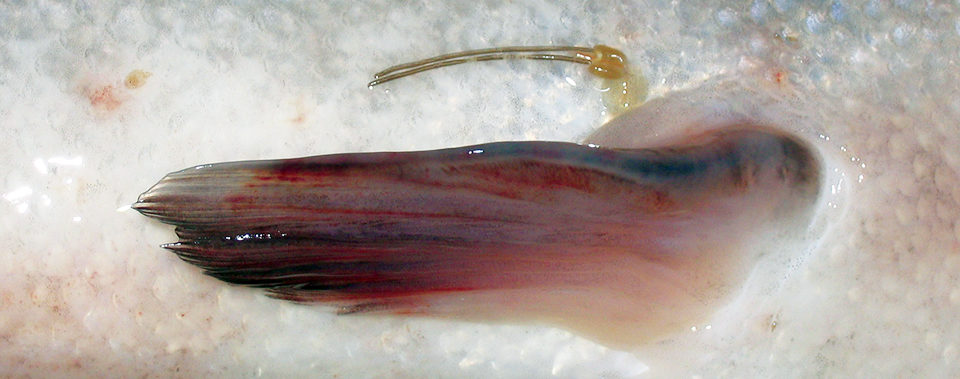
Bath treatment trial
In response to a request from the Norwegian fish-farming industry, the authors performed a trial to document safe and effective bath treatments against sea lice infestations in large net pens using tarpaulins that covered both the sides and bottoms of pens or skirts that covered the sides of the pens to define the treatment volume.
During late 2008 and early 2009, water samples were taken during commercial delousing to see how well deltamethrin was distributed throughout the net pens in real life. Deltamethrin is the active substance in Alpha Max, one of the bath treatments approved to treat for sea lice. A test method based on gas chromatography-mass spectrometry/mass spectrometry developed at the Central Science Laboratory in England was used to measure the deltamethrin directly in the sea water with sensitivity within 1 percent of the recommended dosage.
Delousing with skirts
Four sea sites with 50-m-diameter pens and experience using deltamethrin bath treatments participated in the study. The sites were located from county Rogaland in the south to county Trøndelag in the north of Norway. A dozen bottles of Alpha Max were mixed with 500 to 1,000 L of sea water as a premix. Treatment time was set at 40 minutes, as 30 minutes is approved for tarpaulins.
Each site used different technical equipment. Further differences were observed with regards to skirt dimensions, feeding regimes, oxygenation regimes and observations of fish behavior. Water samples were taken with special bottles at two or more locations in each pen and at different depths and times after dosage. Efficacy and environmental data were also recorded at each site.
Results
The trial showed that when applied correctly, it is possible to obtain deltamethrin levels of 1 to 2 ppb and a delousing efficacy of 95 to 100 percent. Deltamethrin values of approximately 2 ppb were expected in the net pens surrounded by skirts, but the values varied at different sites. As expected, high concentrations (10 ppb) were measured close to the end of the dosage hose, and low concentrations resulted if the skirts did not overlap and allowed leakage of the treatment. Examples of deltamethrin distribution during different bath treatments are shown in Figs. 1, 2 and 3.
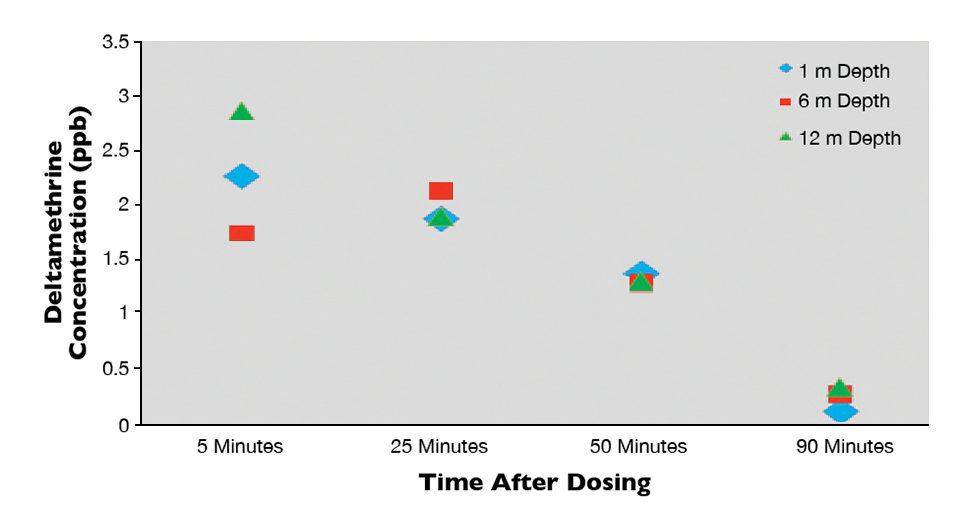
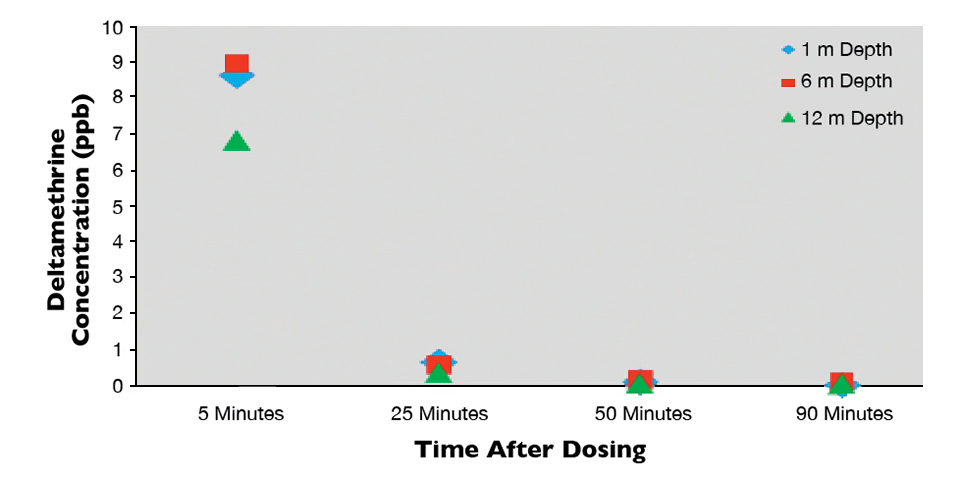
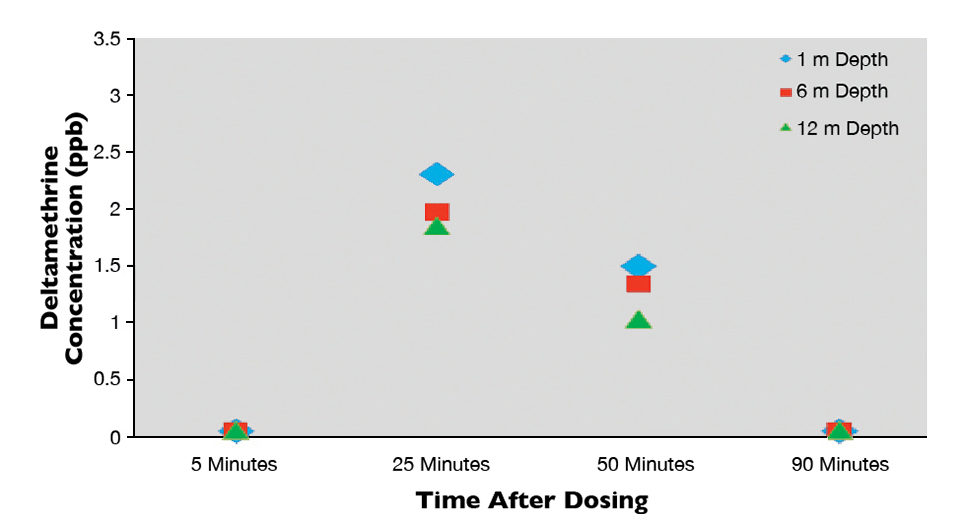
The study showed that it requires skill, experience, know-how and accuracy to perform satisfactory delousing with skirts. The skirt ends must sufficiently overlap, the net pen must be lined up with the fish kept in the upper water layer during the treatment. Further, the results showed more even distribution of the medicine when it was applied with a perforated hose pulled across the surface of the net pens.
Recommendations
Delousing with bath treatments should ideally be done with tarpaulins or well boats to ensure the most even distribution of medicine in time and volume. The swimming of the fish, dosing over a large area and oxygenation are important parameters to ensure an even distribution and therapeutic dose of the medicinal products throughout the net pens.
A challenge is that tarpaulins for 50-meter and larger net pens are not yet mass produced. It should also be mentioned that the use of tarpaulins requires technical equipment and training that is not easily available short term.
(Editor’s Note: This article was originally published in the November/December 2009 print edition of the Global Aquaculture Advocate.)
Now that you've finished reading the article ...
… we hope you’ll consider supporting our mission to document the evolution of the global aquaculture industry and share our vast network of contributors’ expansive knowledge every week.
By becoming a Global Seafood Alliance member, you’re ensuring that all of the pre-competitive work we do through member benefits, resources and events can continue. Individual membership costs just $50 a year. GSA individual and corporate members receive complimentary access to a series of GOAL virtual events beginning in April. Join now.
Not a GSA member? Join us.
Authors
-
Frode Fridell
PHARMAQ A.S.
Harbitzalléen 5
Oslo, Norway -
Bernt Martinsen
PHARMAQ A.S.
Harbitzalléen 5
Oslo, Norway -
Svein Alexandersen
PHARMAQ A.S.
Harbitzalléen 5
Oslo, Norway -
Jan Oppen Berntsen
PHARMAQ A.S.
Harbitzalléen 5
Oslo, Norway[111,110,46,113,97,109,114,97,104,112,64,110,101,115,116,110,114,101,98,46,110,101,112,112,111,45,110,97,106]
Tagged With
Related Posts

Health & Welfare
10 paths to low productivity and profitability with tilapia in sub-Saharan Africa
Tilapia culture in sub-Saharan Africa suffers from low productivity and profitability. A comprehensive management approach is needed to address the root causes.

Intelligence
A land grab for salmon (and shrimp) in upstate New York
The operators of Hudson Valley Fish Farm see their inland locale as a pilot to prove that land-based fish farming, located in close proximity to major metropolitan markets, can be successful.

Aquafeeds
A look at protease enzymes in crustacean nutrition
Food digestion involves digestive enzymes to break down polymeric macromolecules and facilitate nutrient absorption. Enzyme supplementation in aquafeeds is a major alternative to improve feed quality and nutrient digestibility, gut health, compensate digestive enzymes when needed, and may also improve immune responses.

Health & Welfare
A look at tilapia aquaculture in Ghana
Aquaculture in Ghana has overcome its historic fits and starts and is helping to narrow the gap between domestic seafood production and consumption. Production is based on Nile tilapia.


